Made in L.A. 2014, the Hammer Museum’s second foray into the biennial circuit, functions as a huge collage of in-process and current artistic activity in Los Angeles. The exhibition is ambitious in its scope without pressing too many artists into service. The curators, Connie Butler, chief curator at the Hammer, and Michael Ned Holte, a one-time critic of the 2012 avatar of Made in L.A., rely mostly on thirty-five emerging and under-represented artists. Some of the selected artists present shows within the show, allowing artist collectives and mini group shows to co-exist within the biennial. The Hammer biennial gives an alien visitor like me a good idea of what artists in Los Angeles are up to. In fact, this biennial is productively staged by, for, and about what Arthur Danto terms the Artworld.1
In an article on Made in L.A. 2014 in the New York Times T-Magazine, Holte reports, “We’re convinced all the artists we’ve invited to be in the show are worthy of more attention. No artist in the show had heard of every other artist.”2 This idea of the relative obscurity of the artists seems key to this biennial, which rejects the customary discipline of finding new artists and contextualizing them with well-known artists. It is courageous to make an exhibition of artists whose importance hasn’t been established. It lends the biennial an atmosphere of flux and provisionality that I appreciate.
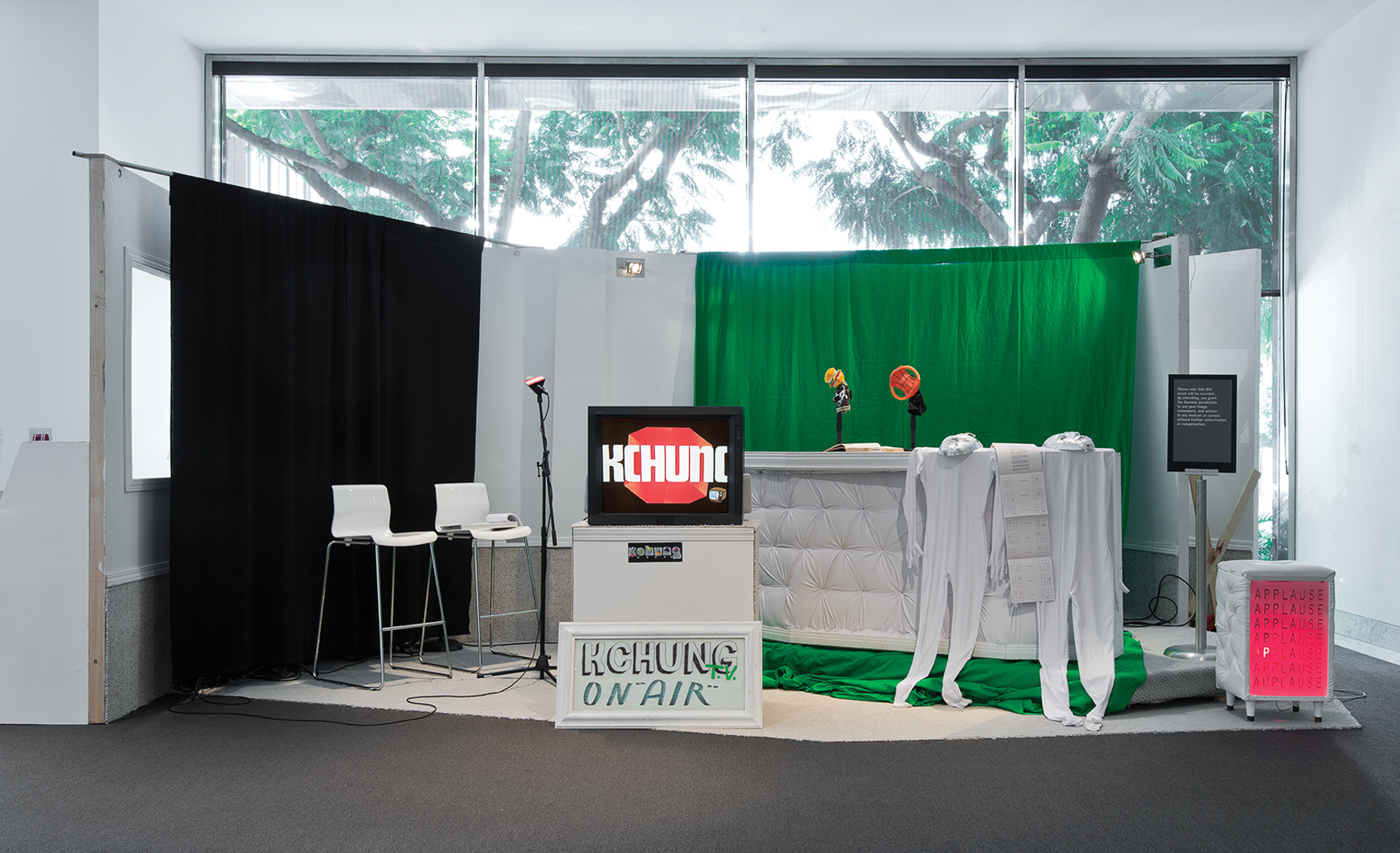
KCHUNG TV, 2014. Installation view, Made in L.A. 2014, Hammer Museum, Los Angeles, June 15–September 7, 2014. Photo: Brian Forrest.
Despite the curators’ genuine commitment to art, artists, and to providing access to and spaces for various artist-centered networks and communities, the presentation of the work often ends up feeling stagey and inscrutable. Some of the work’s opacity is a result of its open-ended and provisional nature, and some of it is due to the insularity of the Artworld from which it springs, all of which are limits and strengths. The decision to show emerging artists and artist-networks leads, in several instances, to staging works in process and showcasing projects that fall short in concept.
The first installation encountered is the working set of a temporary TV station that broadcasts on weekends for the duration of the Hammer biennial. The station is run by KCHUNG, which is a community of over 200 equally billed if not equally involved artists, musicians, and free thinkers who have been regularly and cooperatively running a radio station since 2010 out of Chinatown on 1630 AM.3 About a third of the artists in the biennial are also participants in KCHUNG and, undoubtedly, many others listen to them. It is presumably a nice community of people who know each other, could know each other, or eventually will know each other. Welcome to the Artworld.
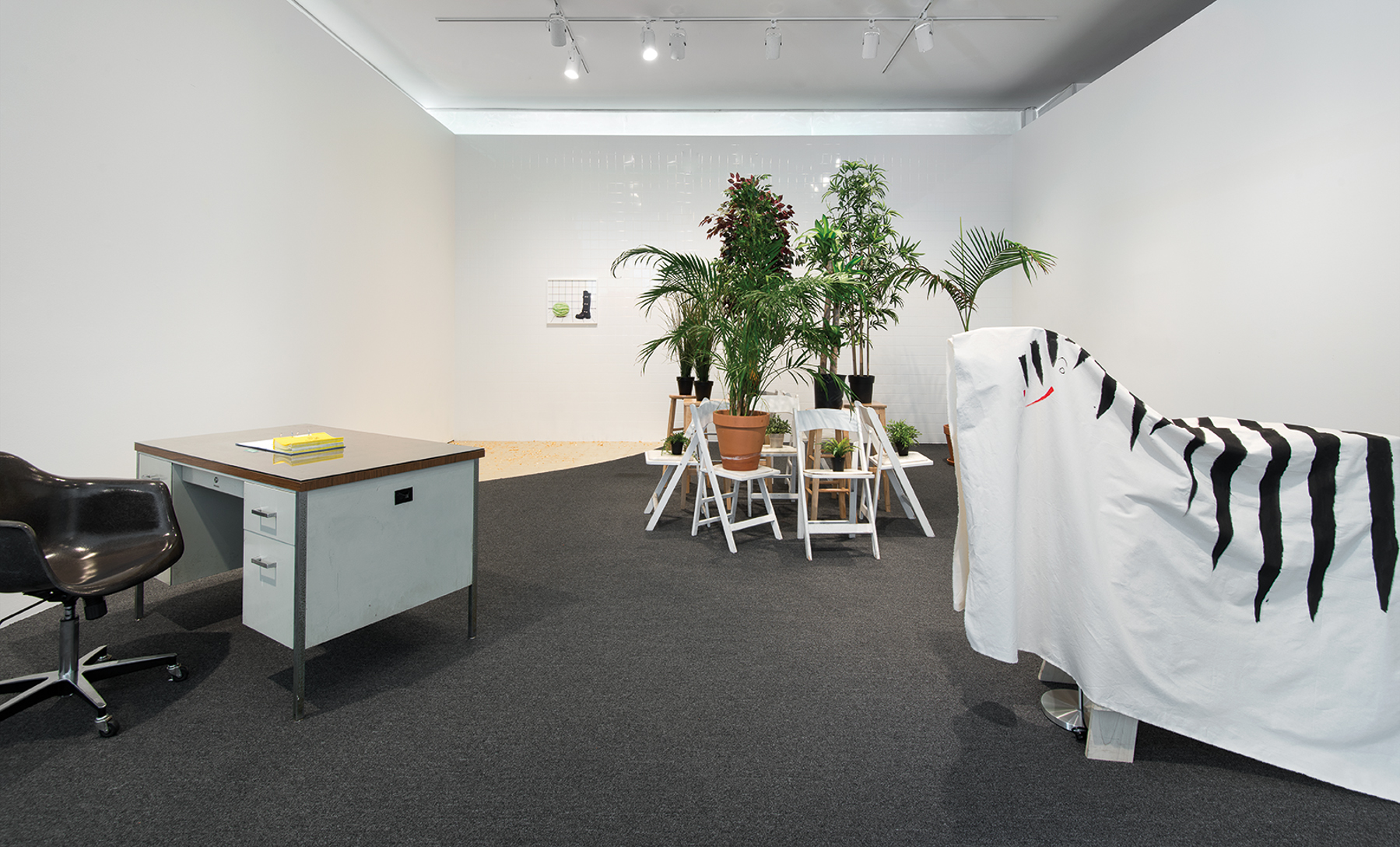
Margaret Lee, Für die Kinder Düsseldorfs [Zebra] (This Zebra is from Düsseldorf), 2014. Installation view, Made in L.A. 2014, Hammer Museum, Los Angeles, June 15–September 7, 2014. Photo: Brian Forrest.
The best one can manage is a few minutes standing in front of the monitor wondering about the recursive relationship between the performance presented on the TV and the set as art. One can’t comprehend the TV show or the radio program on-site in the museum. The set simply alerts us to the activities of KCHUNG, since KCHUNG within the museum is not really KCHUNG as much as it is a staging of the KCHUNG process.5
In the lobby gallery to the right of the KCHUNG set is the project organized by Lauren Mackler’s Public Fiction. Another off-site community-building endeavor invited to participate in the biennial, Public Fiction presents six different solo exhibitions and commissioned texts in the lobby gallery over the run of the show. According to the Hammer pamphlet handed out in the museum, “Each component will be presented within a set built by Public Fiction.” Again, the word “set.” Staging art seems to be the vogue. Yet, the figure of the “set” does not assist in decoding the work. The week I went, I saw the work of Margaret Lee. Among a stage of a quarter circle of gold flooring with a wall of white bathroom tiles were a surreal photograph of a watermelon and a boot (Watermelon Boot [anticipation or something], 2011), fake and real plants sitting on chairs and stools, and a hobby horse draped with a zebra-pattern-painted drop cloth (Für die Kinder Düsseldorfs [Zebra], 2013). Paired with Lee’s work was a commissioned text by Sarah Heyward, He Had to Work Late, about a girl’s late night thoughts upon going to her father’s psychiatry office to make out with her beau. The relationship between the two is obscure and is related only by the artists responding to the shared prompt of the description of the room.6 Concurrent and related Public Fiction events based on a standup comedy model take place off-site, thus leaving the viewer feeling like she is only getting part of the picture. And yet, pushing the viewer out of the museum, which is not the real site of the project, accomplishes something novel for a biennial—taking up the challenge of presenting work that exists outside a museum.
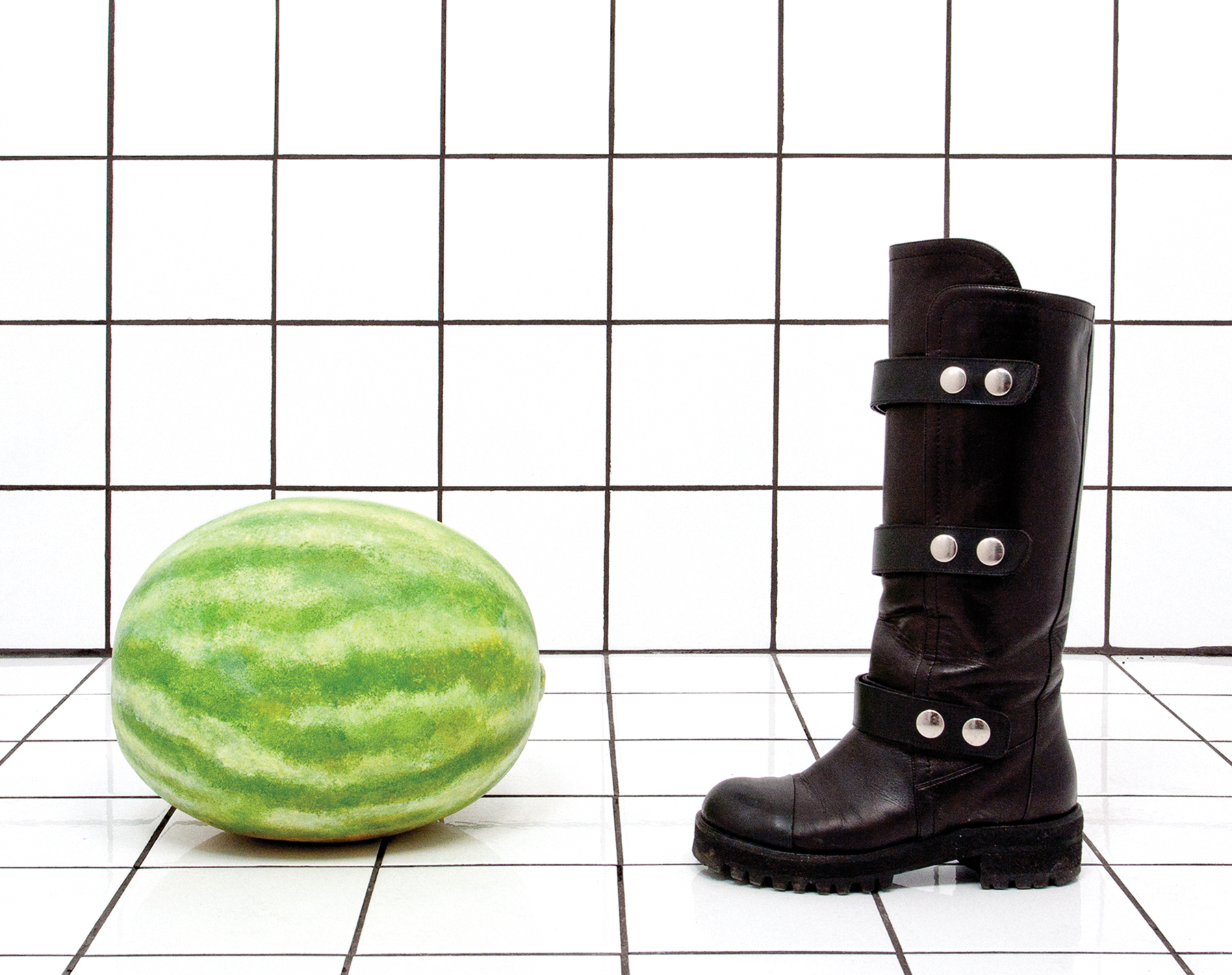
Margaret Lee, Watermelon Boot (anticipation or something), 2011. Archival pigment print, 12 × 24 inches. Courtesy of the artist and Jack Hanley Gallery, New York. Exhibited as a part of A Public Fiction by Public Fiction for Made in L.A. 2014 at the Hammer Museum.
Over against the lobby wall are designer Harsh Patel’s printed works, mostly on newsprint, with bold and clean, if purposefully hard-to-decipher, graphics (all from 2014). Disappointingly, the works are presented in vitrines, with no interaction possible. I liked the open-endedness of interpretation the graphics figured, but I resented that I could not flip the pages, handle the goods, pass them to friends, see what the brouhaha around his work is about.7 As an early and key member of KCHUNG, Patel is an insider in the Made in L.A.’s Artworld, and the presentation suggests that his work is for insiders only.8
In the halfway landing of the massive, double-height lobby staircase is Clarissa Tossin’s Brasília, Cars, Pools and Other Modernities (2009–13), which includes a used Volkswagen Brasília with lettering indicating a pool cleaning service.9 The car is paired with various pool service appurtenances in pristine condition. The walls of the stairwell are lined with tile-patterned wallpaper, upon which hang a photo of a pool and Tossin’s coy self-presenting letter to the Brazilian architect Oscar Niemeyer. In her letter, she lays out her interest in utopian modernism, in general, and, in particular, in Niemeyer’s only residential work in the United States, the Strick House, which happens to be in Santa Monica. I say coy because the letter format slyly references the fact that Niemeyer designed that pictured pool and house for the Stricks via post, because he was banned from entering the United States for his leftist political associations. Brasília, Cars, Pools and Other Modernities contains a complex set of references, but its success is only partial. Even if we are clever enough to figure that Tossin drove the car from Brasília, in her native Brazil, to her adoptive home of Los Angeles in order to (pretend to) clean the pool of the Strick House, we arestill left wondering what this installation means beyond being an overdetermined and rationalized exposition of the interrelatedness and two-way traffic of utopian modernism.10
In the upstairs landing, Emily Mast’s ENDE (Like a New Beginning) (2014) is projected on a yellow wall. In the video, the artist has employed a large cast of actors who use the Hammer museum as a stage set. In each of many scenes, they manipulate common yellow and brown objects such as lemons, baguettes, painted-over basketballs, paper boxes, and brown tape.11 The video is a series of fairly quick edits of various isolated movements and group actions, such as piling atop each other, holding each other in strained positions, running onto a stage, crashing into a pyramid of yellow plastic cups, hiding behind a sheet of cloth, eying each other, manipulating make-up on their faces, taping and tackling boxes, and general mayhem. The gestures are absurdist, excessive, pensive, and intensely human, and they put me in mind of the extraordinariness of ordinary life. I found myself thinking of the interconnectedness of all life and how one action leads to another reaction. Mast’s video and installation work is repeated across the space of the museum, as if to indicate the eternal mutability and provisional nature of ENDE. The props used in the performance are assembled into separate color-coordinated installations, and a video that functions like an addendum or a coda to the main performance video is projected up in the anteroom to the bathrooms, which signaled one interpretation to the work. In it a middle-aged woman and a young girl alternately sing a 1973 T. Rex song, “Life Is Strange.” Contrary to the timelessness the artist strives for, the work actually keeps such a world in play as its suppressed or delayed other.12 One is gently aware of the artwork being a refuge both for the artist and the viewer.
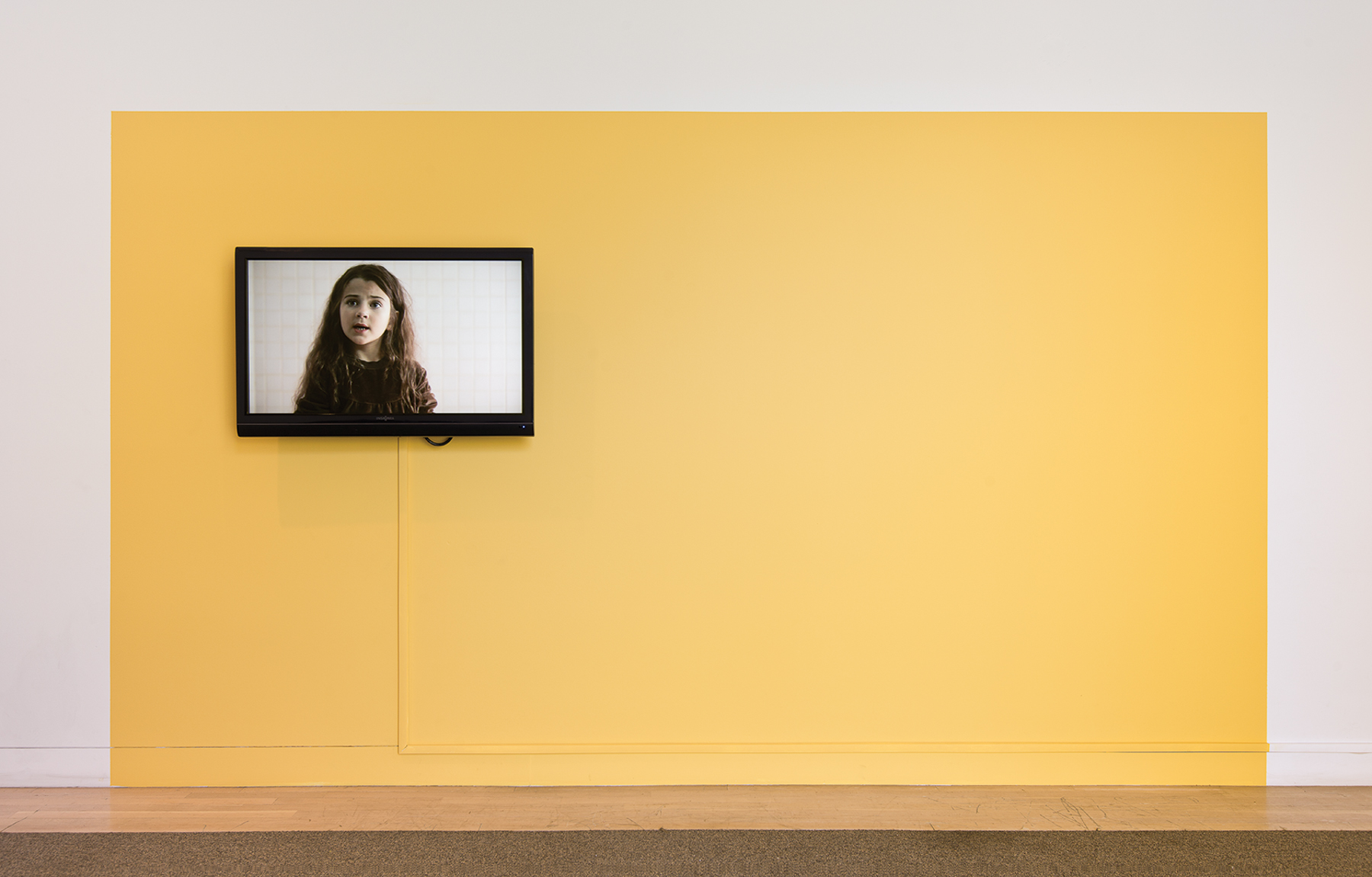
Emily Mast, ENDE (Like a New Beginning), 2014. Installation view, Made in L.A. 2014, Hammer Museum, Los Angeles, June 15–September 7, 2014. Photo: Brian Forrest.
Of course, the exhibition also had works with a political theme or impulse. When I visited, Piero Golia’s The Comedy of Craft (Act 1: Carving George Washington’s Nose) (2014) was in a grave state of unfinish in the Lindbrook Terrace area. I spied small rough models of noses on a table, work lights, some odd tools, and many huge and practically untouched blocks of white polystyrene foam waiting to be shaped into a full-scale copy of the twenty-one-foot nose of the nation’s first president, as carved on Mt. Rushmore.13 Completion of the carving appears highly unlikely, and it is almost as if to finish Golia’s copy would be to doom George Washington’s Mt. Rushmore monument to the loss of its noble nose. After all, the first thing figurative statues seem to lose is the nose, accidentally or mean-spiritedly knocked off. By concentrating his comic energy on a fragment of a monumental figure, Golia’s work brings panache and humor to a whole history of Western expansionism, nation building, and political pitfalls.
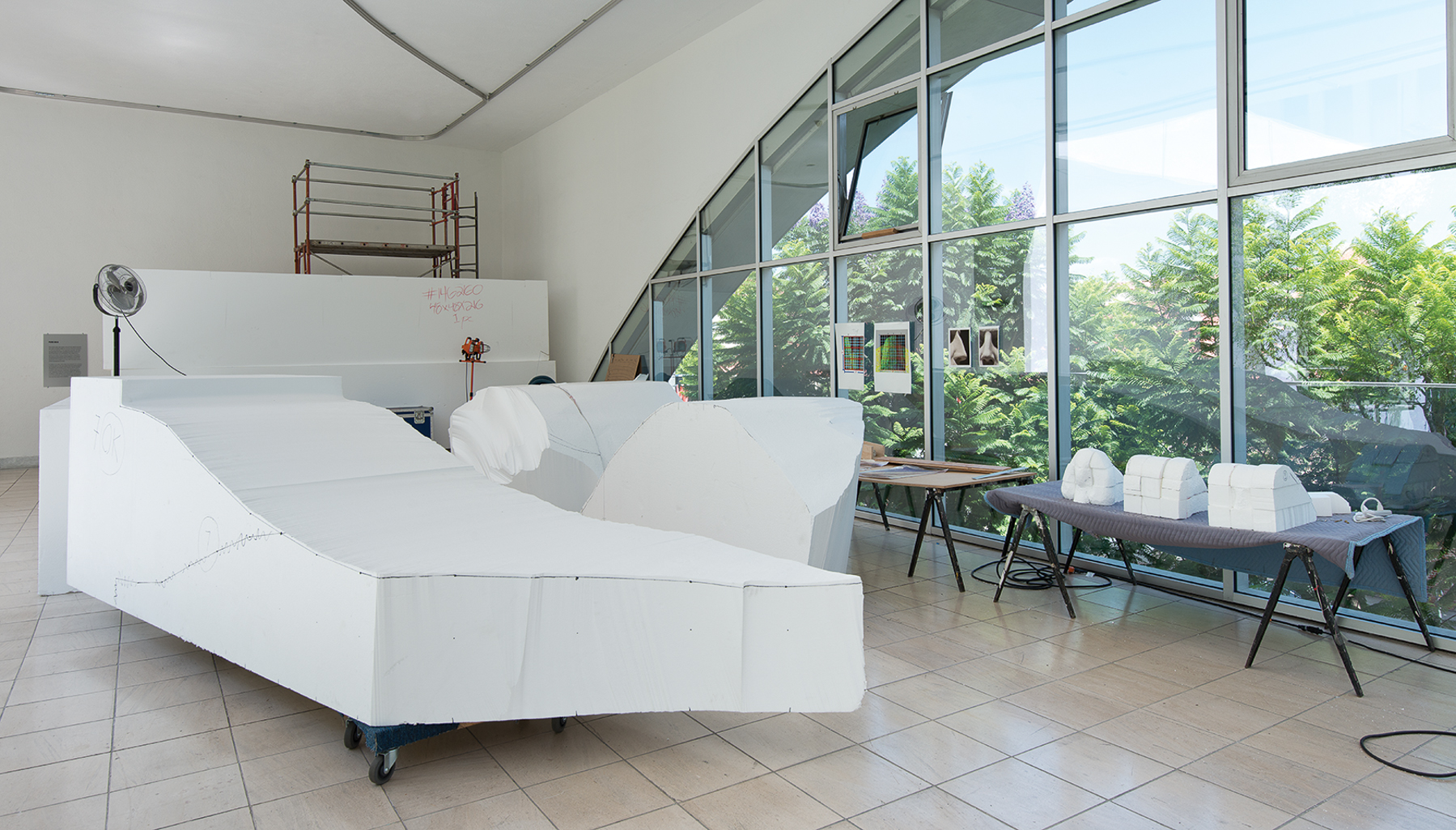
Piero Golia, The Comedy of Craft (Act 1: Carving George Washington’s Nose), 2014. Installation view, Made in L.A. 2014, Hammer Museum, Los Angeles, June 15–September 7, 2014. Photo: Brian Forrest.
A.L. Steiner’s Accidenthell (2014) appears to be a similarly ongoing endeavor, but is more serious-minded. Her three-wall installation features collaged digital photographs of her community, both queer and political, and video excerpts from television news about energy extraction and private prisons. Steiner says, “I’ve been thinking more about drought, water, heat, food, energy, power, prisons and otherness. These things feel criminal to ignore, and the rate and intensity at which one experiences them is impossible to suspend.”14 An internet feed of constantly rising statistics from World Population to Abortions to Causes of Death to Bicycles Produced streams live on a small monitor embedded within the collaged wall. The work’s format emblematizes its content, which is perpetually unfinished and constantly refreshed. But I did not find that the work’s interlinking of the artist’s safe haven of community with the surging statistics and the uses of corporate capital produced potent new readings of its content.
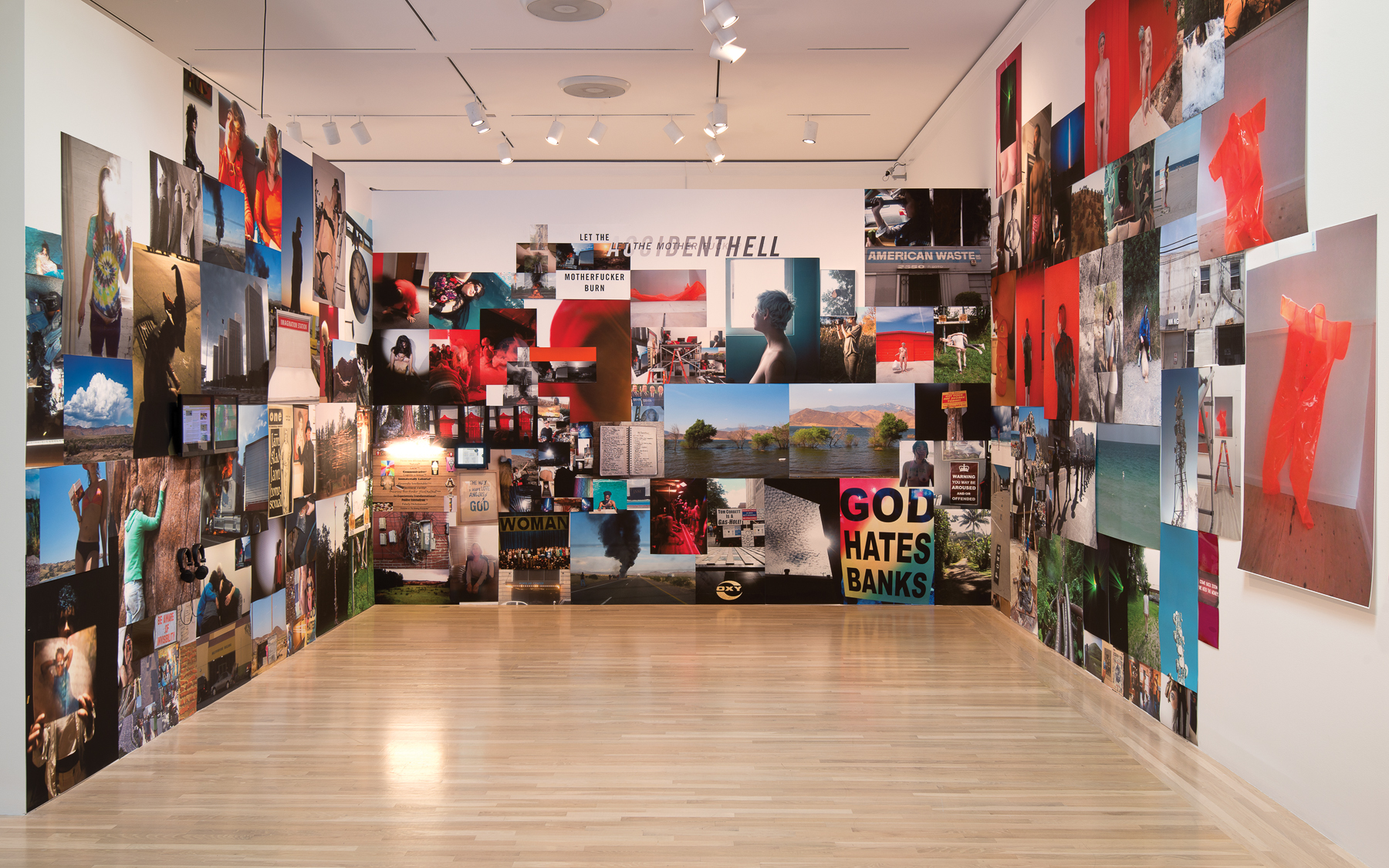
A.L. Steiner, Accidenthell, 2014. Installation view, Made in L.A. 2014, Hammer Museum, Los Angeles, June 15–September 7, 2014. Photo: Brian Forrest.
Wu Tsang’s 2-channel video, A day in the life of bliss (2014), is a fictitious account of a day in the life of a seemingly chill gender-queer club-going character named BLIS. BLIS, performed by Wu Tsang, explores movement and makes faces in the mirror in one sequence, is happy at the center of a celebrity picture taking photo session in another, and cattily chats over fashionable makeup and clothing choices in another. Eventually, police raid a club where BLIS and friends are partying. The group is Taser-ed and tied up. The ending is declared when BLIS orders the police: “Untie us.” That wording invokes a whole raft of longing for freedom from all sorts of shackles.
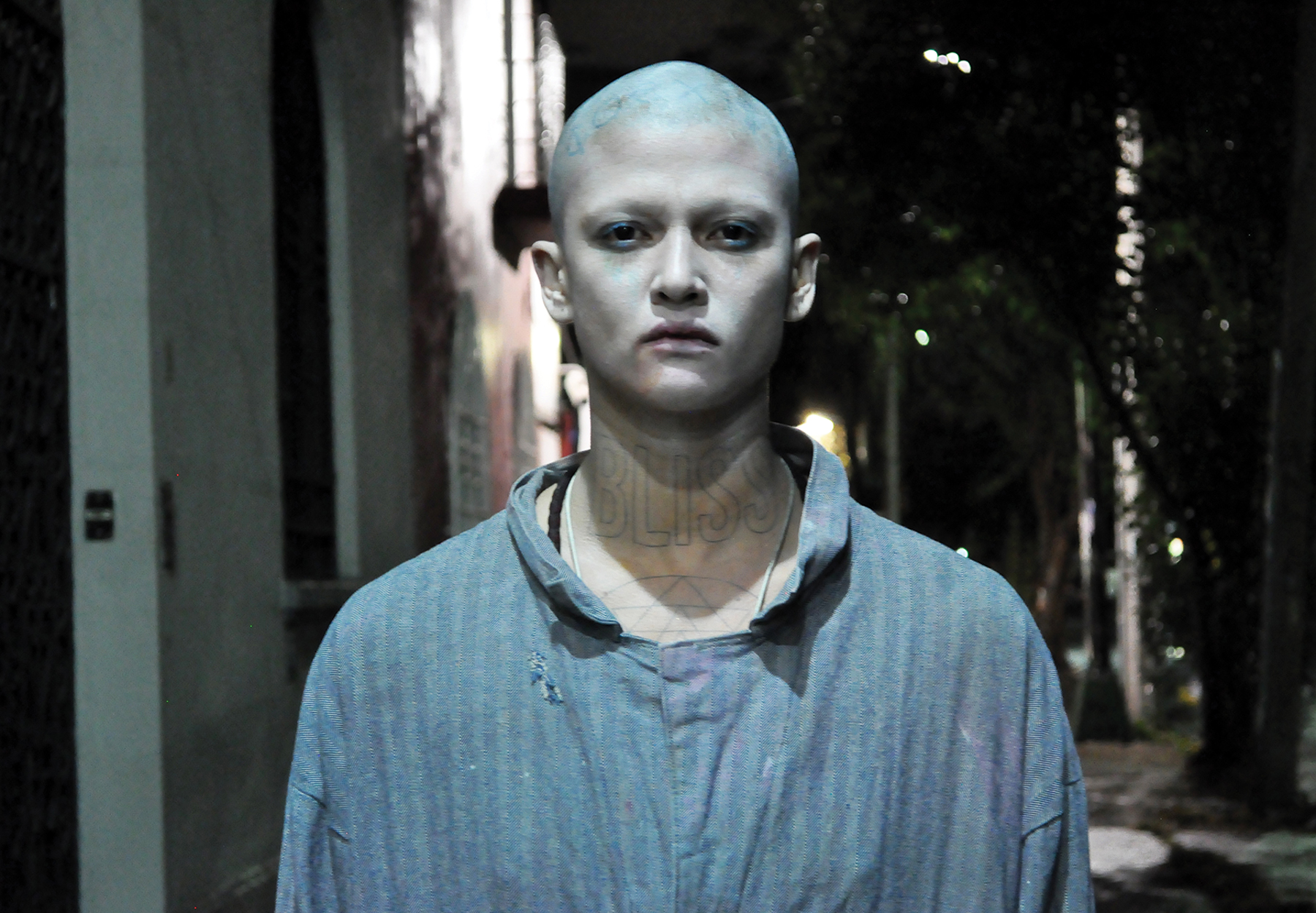
Wu Tsang, A day in the life of bliss, 2014. Two-channel HD video, color, sound. Approximately 20:00 min. Courtesy Isabella Bortolozzi Galerie, Berlin, and Clifton Benevento Gallery, Los Angeles.
The disparate works of Tsang, Steiner, and Golia are politically charged yet decidedly open-ended; but the biennial does not merely touch upon complicated politics, Artworld insularity, and the provisional and conditional nature of artwork. A fair number of finished artworks made by solitary workers are hung on the walls, placed on pedestals, and mounted as video installations. They proffer a diversity of media and meanings and provide a generous roundup of what’s been happening in Los Angeles studios in the last few years. Disappointingly, most of these works do not break new ground formally or conceptually, but I don’t think that was the aim of this exhibition.
A few installations stand out for their intelligent message communicated through playful address. Broken bits of whitewashed brick in Juan Capistran’s work in the courtyard spell out “I AM HOPING TO SEE THE DAY.” The title of the work is, surprisingly, …put very little trust in tomorrow (2014), a sort of negative umbrella sheltering the melancholic positivity of the spelled out words. Upstairs in a corner, a video projection by Capistrán shows two white-painted hands knocking together whitewashed bricks until they break and crumble. I cannot all rebuild what so many men persist in destroying (2013), uses bricks poetically, as if rejoicing in breaching socio-political brick walls and threatening a riotous flinging of bricks through glass windows. On the floor, in a work titled Crowd Control or Your Fantasy Version of the World Is Doomed to Failure (2014), are political placards, like the ones used by picketing union workers and rallying political activists. However, Capistrán’s placards are made completely of glass, with phrases etched into them, such as “NE TRAVAILLES JAMAIS,” “ALL POWER TO THE PEOPLE,” “RATS GET FAT,” and “U+24B6.” The latter is the Unicode hex value for the circled A, an anarchist symbol popularized by the punk movement in the 1970s. The slogans and the glass seem to be deployed for their power and fragility. In the installation, one blank glass placard propped sideways against the wall was ironically being protected from feisty art kickers by a museum guard. Capistrán’s work is politically ambiguous and ingenious, playing with signifiers of anarchism and punk, while at the same time evincing a certain commitment to non-violent protest through the use of placards and the crumbling of bricks in hand.
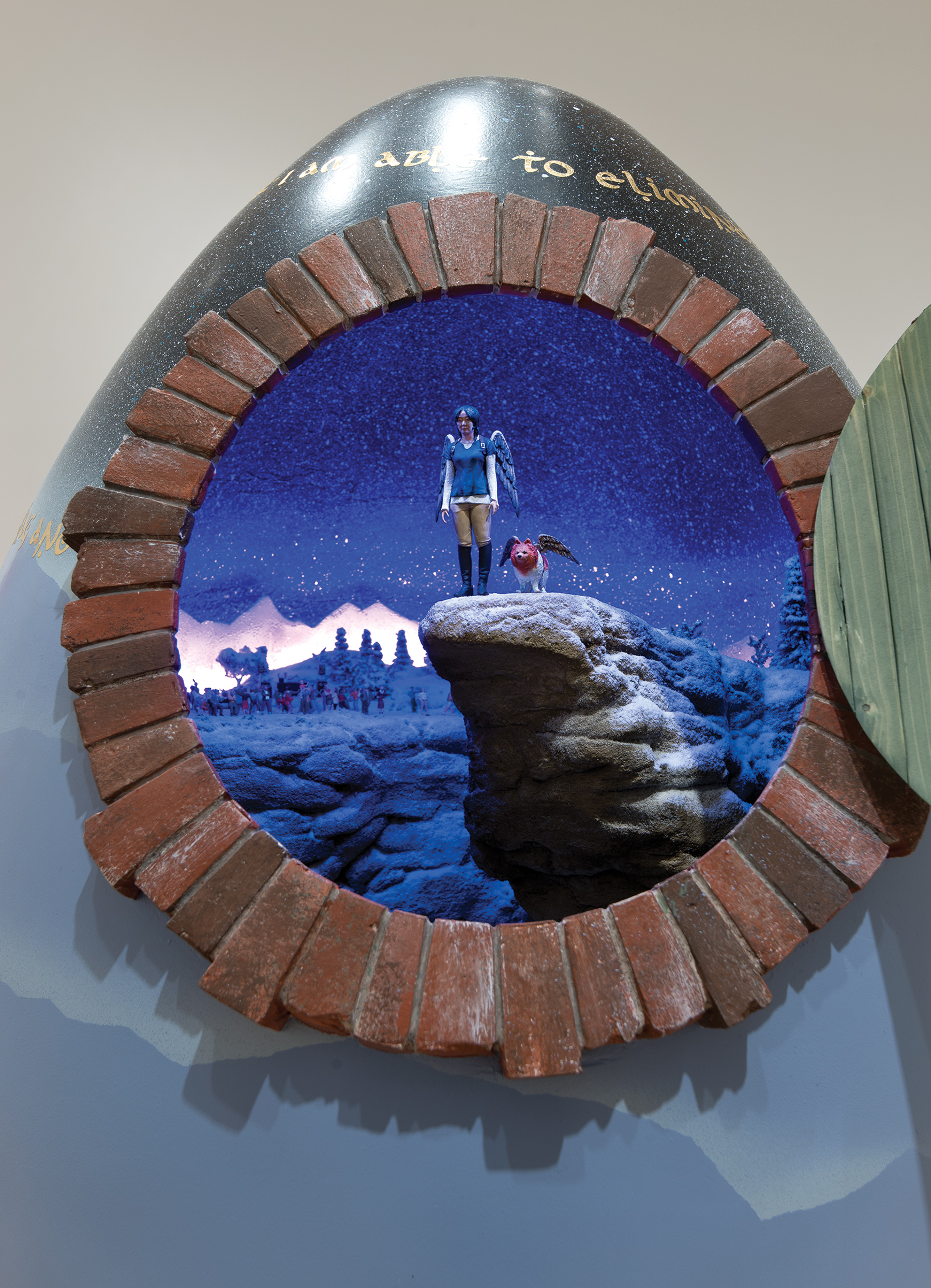
Jennifer Moon, Proposal From My Last Performance on Earth Perspective Date: 2053, 2014. Installation view, Made in L.A. 2014, Hammer Museum, Los Angeles, June 15–September 7, 2014. Photo: Brian Forrest.
Jennifer Moon’s revolution is the result of hard work at sincere self-help, and her work is hokey yet oddly affecting. About twenty years ago, so the story goes, Moon made a pact with a “cosmic entity” to give up romantic relationships in return for the ability to be successful at making art. Now she wants both art and love and has started a revolution, complete with instructional pamphlet, a chart outlining her formula for gaining love, a book detailing the successes and failures of her past romantic entanglements, and a large, colorful fiberglass egg. Within the egg, miniature sculptures of the artist and her dog, both outfitted with wings, stand overlooking the edge of a cliff. The latter work is titled Proposal for My Last Performance on Earth, Prospective Date: 2053, which is when Moon would be 80 and presumably ready to fly away from earth and into the stratosphere. Behind her figure, tiny onlookers are bathed in crassly vivid blue-purple light. For a revolutionary seeking love and abundance, the solitary figure about to fly away is a shocking acknowledgement of the difficulty of finding that, suggesting the fragility of any such closure.
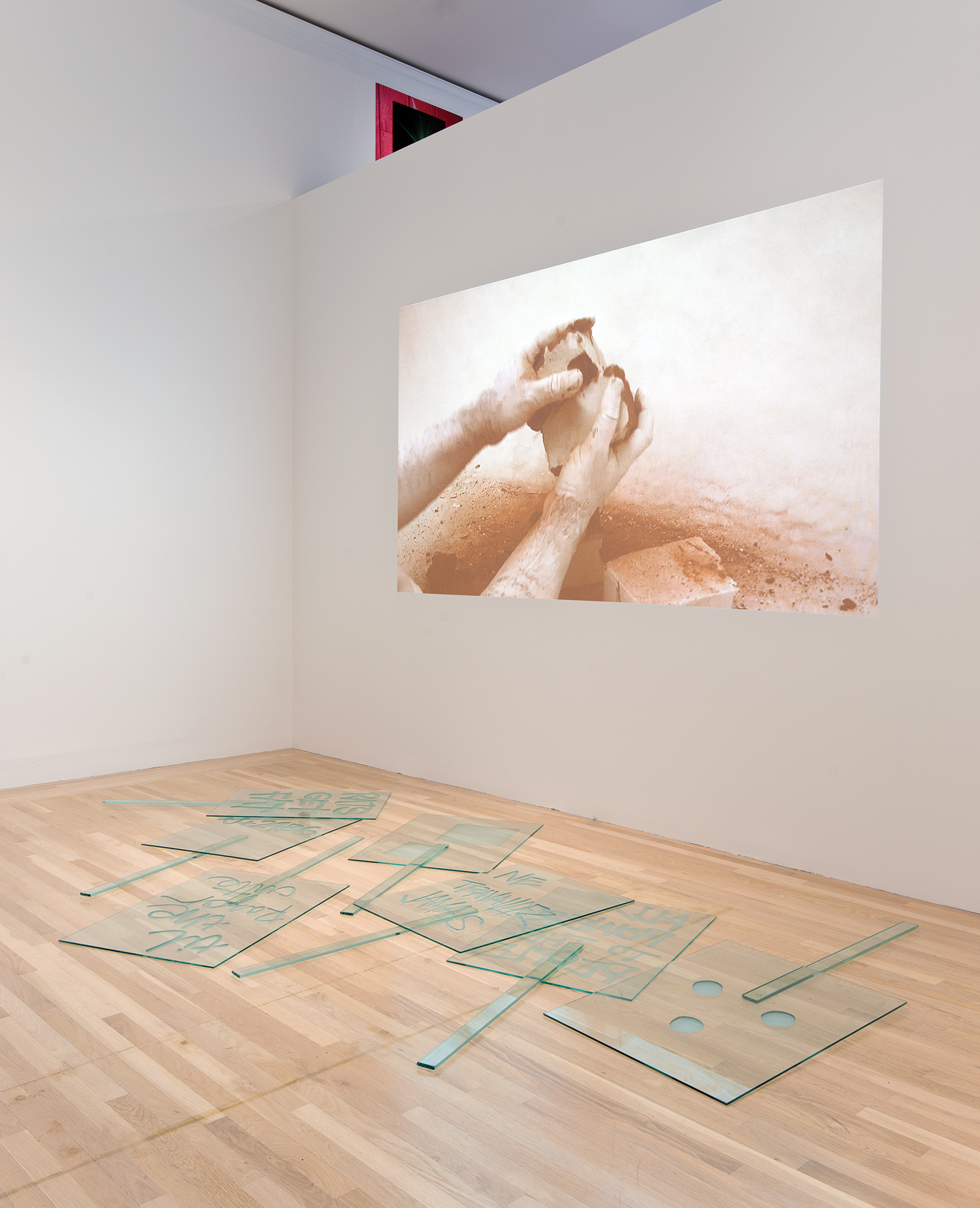
Works by Juan Capistrán. Installation view, Made in L.A. 2014, Hammer Museum, Los Angeles, June 15–September 7, 2014. Photo: Brian Forrest.
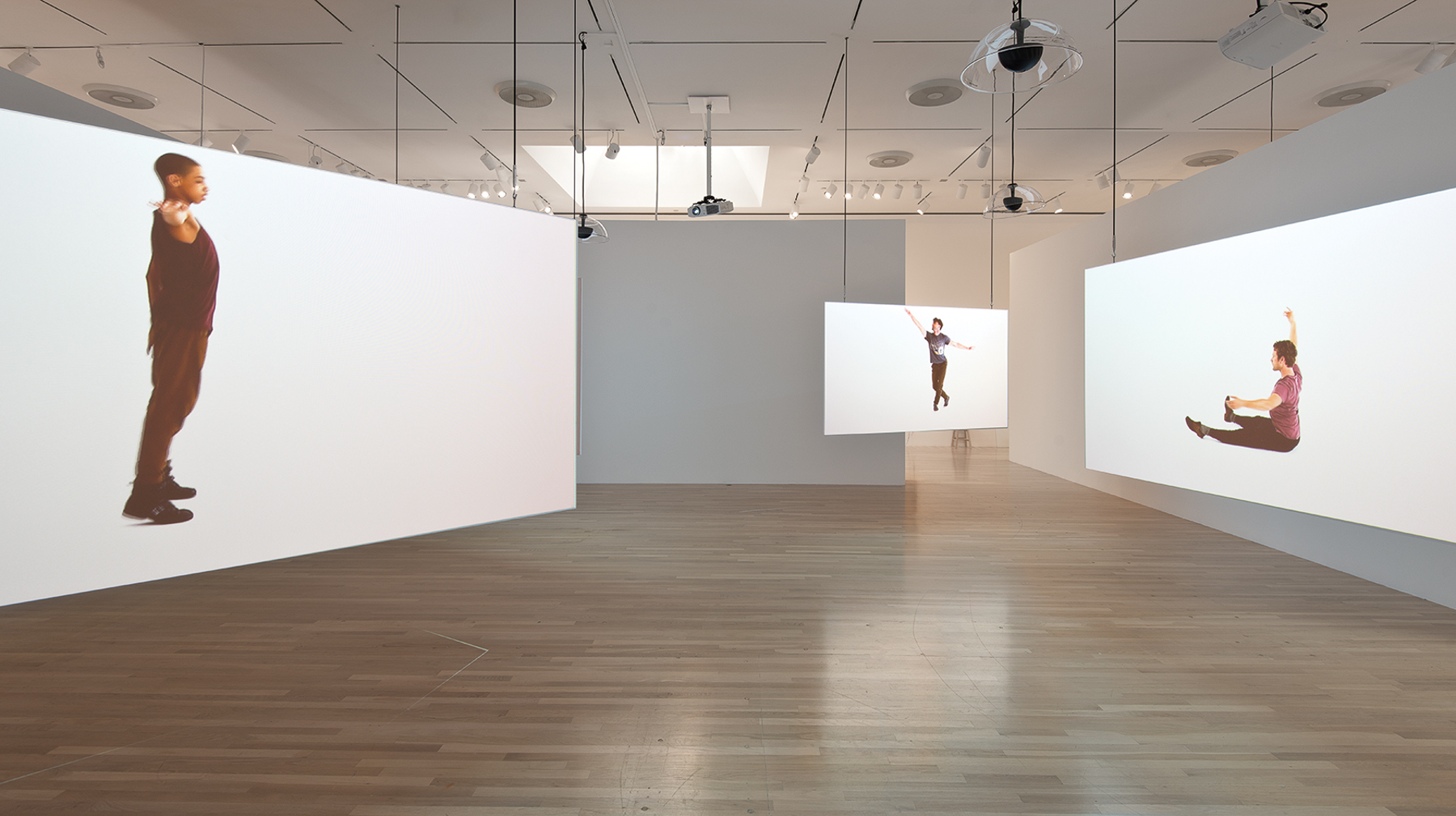
Gerard & Kelly, Kiss Solo, 2012. Installation view, Made in L.A. 2014, Hammer Museum, Los Angeles, June 15–September 7, 2014. Photo: Brian Forrest.
An expression of love and art is simultaneously parsed in Gerard and Kelly’s four-channel video and audio installation, Kiss Solo (2012). The work was elegantly presented on four angled and suspended screens, each paired with a parabolic speaker overhead, allowing one to be absorbed in each video separately. On each channel, a single dancer enacts the artists’ voiced description of Tino Sehgal’s popular work, Kiss (2007). In Segal’s live work, two hired interpreters enact famous kisses from the history of art. In Gerard and Kelly’s Kiss Solo, the same descriptors are unpacked differently in each of the four dancers’ fragmentary actions, reflecting the impossibility of a coherent narrative. It poignantly reveals the abyss between idea and action. We are only ever going to get partial truths.
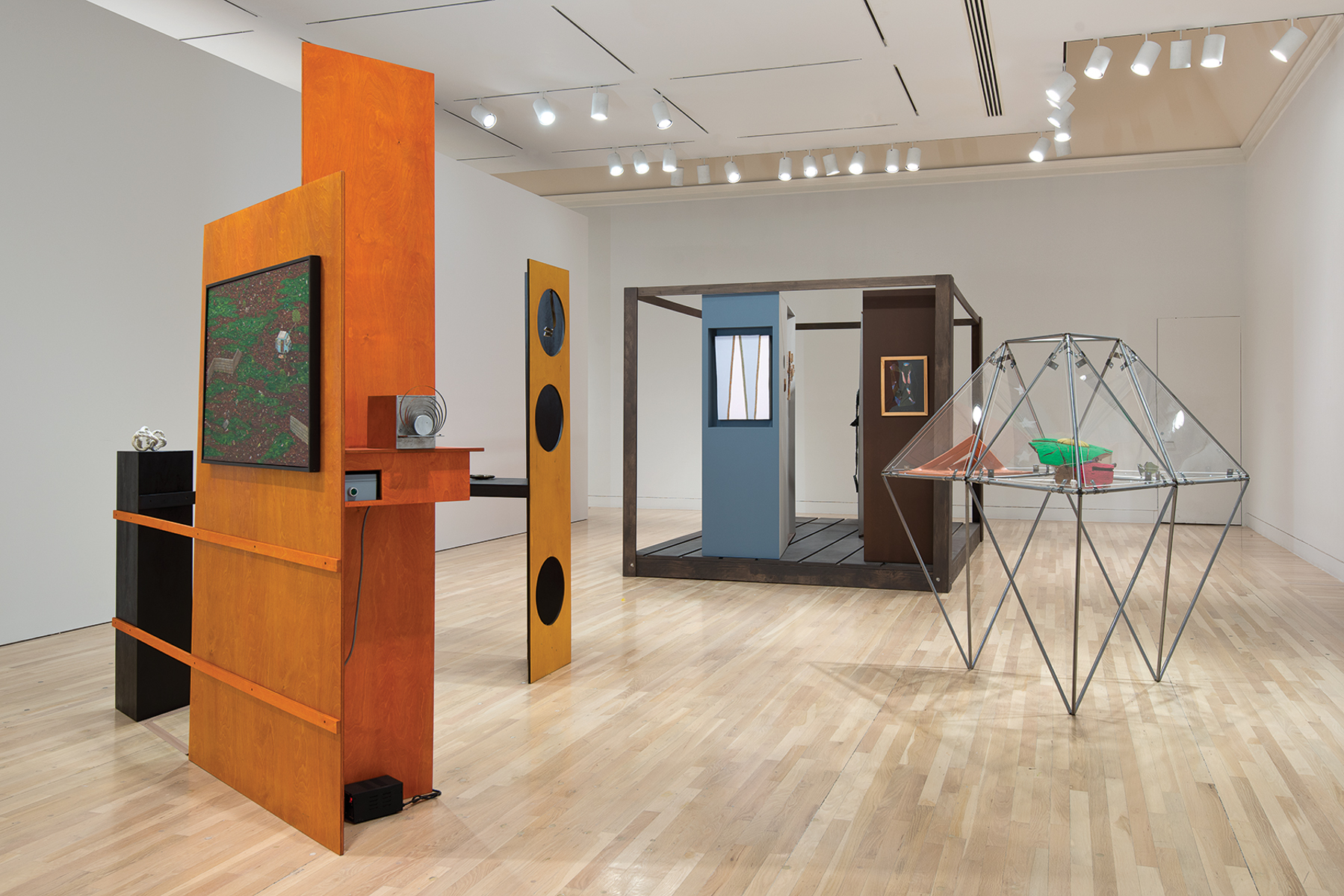
Los Angeles Museum of Art. Installation view, Made in L.A. 2014, Hammer Museum, Los Angeles, June 15–September 7, 2014. Photo: Brian Forrest.
These shards from the studios of artists working in Los Angeles suggest that, in a fragmentary contemporaneity, a partial and provisional solution seems likely, both at the level of the artwork and at the level of organizing a biennial. At many points, the works presented were frustrating, even if I liked the impulses behind those works. But I was grateful for the introduction to off-site activities in Los Angeles, not only KCHUNG radio, Public Fiction’s events and publications, and Harsh Patel’s graphic works, but also in the form of the Los Angeles Museum of Art, run by artist Alice Könitz, and the dance studio of James Kidd, whose works are staged elsewhere in the exhibition. Making visible and accessible the process of an artist or collective is an ongoing challenge for curators, especially when they choose to reconfigure or represent the efforts as art. As a result, some work is staged in-process and some work is staged as if it is complete, when in fact we are seeing merely the detritus of the process. In this biennial, where everything is provisional and the process is unfinished, the exhibition seems to be an incomplete work by design.
Neha Choksi is an artist currently living in Mumbai.
